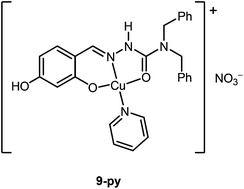Copper(ii) complexes of substituted salicylaldehyde dibenzyl semicarbazones: synthesis, cytotoxicity and interaction with quadruplex DNA†
Abstract
A series of substituted salicylaldehyde dibenzyl semicarbazones [RC6H3(OH)CH![[double bond, length as m-dash]](https://www.rsc.org/images/entities/char_e001.gif) N–NHCON(CH2Ph)2] and their copper(II) complexes were synthesized and characterized. The chloridocopper(II) complexes of the 4-OH and 5-OH substituted ligands (complexes 9 and 7) show modest affinity and good selectivity (over duplex DNA) for the quadruplex formed from the 22AG human telomeric (HTelo) DNA sequence. Substitution of the chlorido ligands of these two complexes with pyridine yielded derivatives (7-py and 9-py) with increased affinity for HTelo. These derivatives also show good selectivity for HTelo over calf-thymus DNA (170- and 211-fold, respectively). The X-ray crystal structures of 9 and 9-py were determined. Molecular docking studies based on these structures show that the complexes stack on the 5′-end of the HTelo quadruplex, with the hydroxyl group forming a hydrogen bond with a guanine residue. Complexes 7, 9, 7-py and 9-py display significant cytotoxicity against MOLT-4 human leukaemia cells. Interestingly, they have low to negligible cytotoxicity against the non-cancerous IMR-90 human fibroblasts.
N–NHCON(CH2Ph)2] and their copper(II) complexes were synthesized and characterized. The chloridocopper(II) complexes of the 4-OH and 5-OH substituted ligands (complexes 9 and 7) show modest affinity and good selectivity (over duplex DNA) for the quadruplex formed from the 22AG human telomeric (HTelo) DNA sequence. Substitution of the chlorido ligands of these two complexes with pyridine yielded derivatives (7-py and 9-py) with increased affinity for HTelo. These derivatives also show good selectivity for HTelo over calf-thymus DNA (170- and 211-fold, respectively). The X-ray crystal structures of 9 and 9-py were determined. Molecular docking studies based on these structures show that the complexes stack on the 5′-end of the HTelo quadruplex, with the hydroxyl group forming a hydrogen bond with a guanine residue. Complexes 7, 9, 7-py and 9-py display significant cytotoxicity against MOLT-4 human leukaemia cells. Interestingly, they have low to negligible cytotoxicity against the non-cancerous IMR-90 human fibroblasts.


 Please wait while we load your content...
Please wait while we load your content...